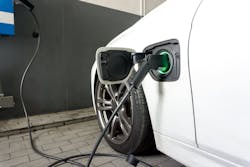Content brought to you by Motor Age. To subscribe, click here.
What you will learn:
All cars sold in California must be Zero-Emissions by 2035On August 26, 2022, the California Air Resources Board (CARB) approved the Advanced Clean Cars II regulations. These regulations are in response to Governor Gavin Newsom’s 2020 executive order that requires all new cars sold in California to be zero-emissions by 2035. California is the first state in the nation to make such sweeping steps toward a zero-emission vehicle future, but other democrat-led states, such as New York and Oregon, are expected to follow suit soon.
Electric vehicle sales are higher in California than anywhere else in the United States—making up 16 percent of total vehicle sales to date in 2022. Comparatively, electric vehicles make up only about 6 percent of total vehicle sales across the United States. However, EV sales are climbing nationwide, due in part to pro-electric vehicle policies from the Biden Administration and state governments.
This summer, the U.S. Congress passed the Inflation Reduction Act (IRA), which includes $369 billion in funding for emissions-reducing policies ranging from large-scale clean energy technology manufacturing investments to electric vehicle tax credits. The IRA includes a tax credit of up to $7,500 for personal electric vehicles. The credit amount depends on a variety of factors, such as whether the vehicle battery meets manufacturing standards, vehicle MSRP price, individual household income and Made-In-America provisions.
On the state level, California is leading the way in advancing electric vehicles with the Advanced Clean Cars II regulations. The Advanced Clean Cars II regulations include a variety of initiatives to set California on the path to zero-emissions by 2035. Most notably for independent repair shops, the Clean Car regulations require the same access and disclosure for zero-emission vehicles (ZEVs) as established in the California Service Information Regulation. This means that independent repair shops in California will be required to have access to the same service information and repair procedures from OEMs as they have with current internal combustion engine vehicles.
Additionally, the Advanced Clean Cars II regulations require standardized tooling to reprogram electronic control units (ECUs) and require standardization for some vehicle tool data. The regulations also require zero-emission vehicles to have a standardized data connecter (such as an OBD-II port) and use standardized communication protocols.
Under these regulations, OEMs will be required to make “powertrain” service and repair information for all zero-emission vehicles available to independent technicians. Powertrain includes all components and systems related to refueling and propulsion. This mimics what is already done for conventional vehicles for service and repair information under CCR 1969.
The Alliance for Automotive Innovation, which represents automakers and automotive suppliers that produce over 95 percent of new vehicles sold in California, voiced their support for the Advanced Clean Cars II Regulations.
“Independent repair shops conduct 70 percent of post warranty repairs," Steve Douglas, vice president for energy and environment at the Alliance for Automotive Innovation states. "They are an essential partner for automakers. This does not change with the transition to an EV future. We have long supported and continue to support inclusion of EVs in the service information requirements in California and would support their inclusion in EPA’s Service Information regulations, so they apply nationwide.”
Overall, there is still a long way to go for wide-scale electric vehicle adoption in the United States. A recent study by Energy Innovation, a climate policy think-tank, found that “it can take many years to realize deep sectoral reductions [in the vehicle marketplace], even with high shares of clean vehicle deployment. This highlights the importance of strong Zero-Emission Vehicle (ZEV) incentives in the next decade, as waiting runs the risk of missing climate goals due to slow stock turnover.”
The Advanced Clean Cars II Regulations are a huge first step in the process to electrifying the American vehicle fleet and including EVs in the service information requirements in California, and in other states that choose to follow in California’s footsteps is vitally important to all independent repair shops.
About the Author
Madi Hawkins
Madi Hawkins works as a Washington D.C. representative of the Automotive Service Association (ASA). She is a recent graduate of Vanderbilt University, where she graduated with a B.A. of Public Policy Studies.

